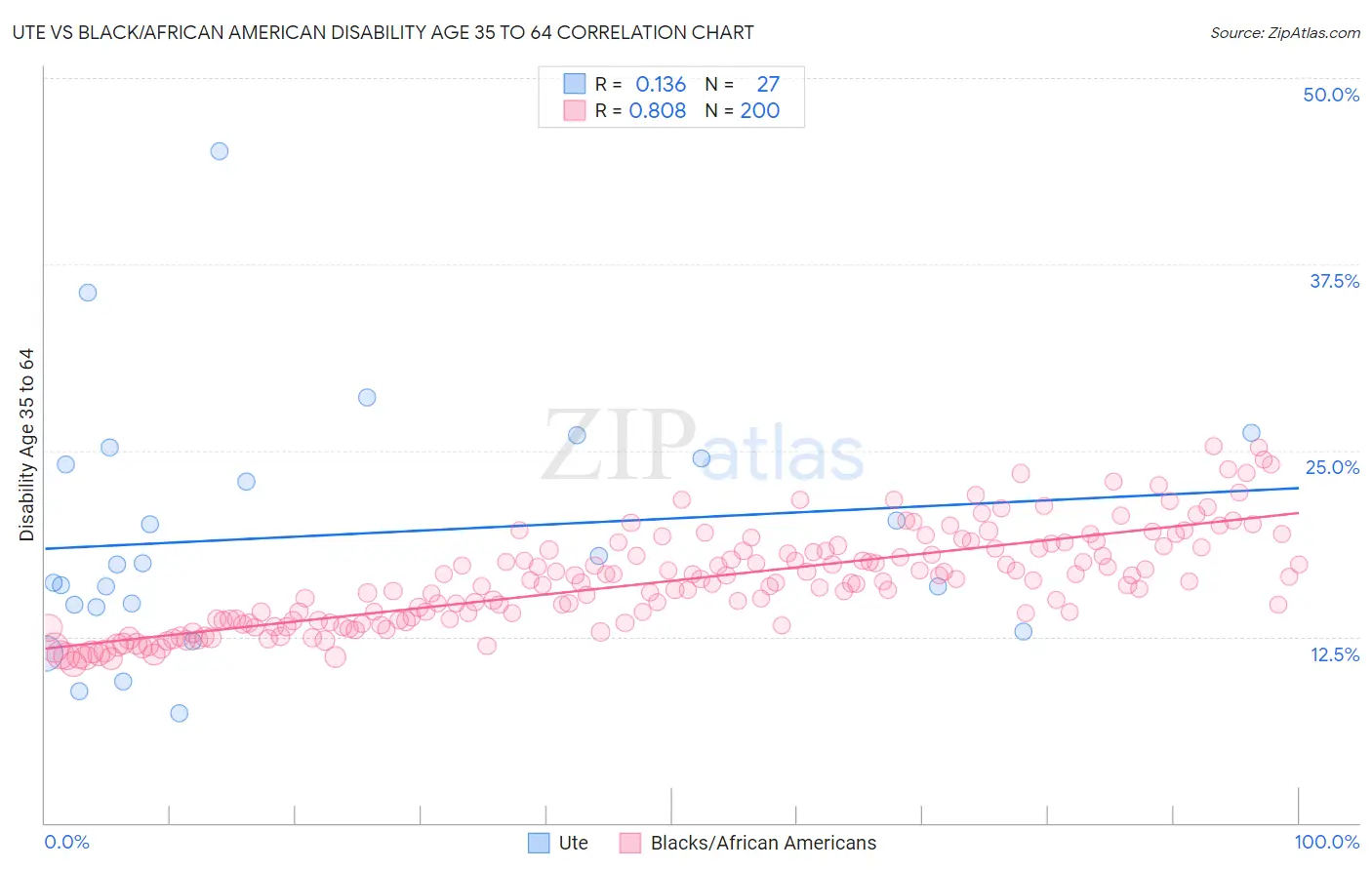Ute vs Black/African American Disability Age 35 to 64
COMPARE
Ute
Black/African American
Disability Age 35 to 64
Disability Age 35 to 64 Comparison
Ute
Blacks/African Americans
13.4%
DISABILITY AGE 35 TO 64
0.0/ 100
METRIC RATING
293rd/ 347
METRIC RANK
14.7%
DISABILITY AGE 35 TO 64
0.0/ 100
METRIC RATING
320th/ 347
METRIC RANK
Ute vs Black/African American Disability Age 35 to 64 Correlation Chart
The statistical analysis conducted on geographies consisting of 55,657,463 people shows a poor positive correlation between the proportion of Ute and percentage of population with a disability between the ages 34 and 64 in the United States with a correlation coefficient (R) of 0.136 and weighted average of 13.4%. Similarly, the statistical analysis conducted on geographies consisting of 565,040,729 people shows a very strong positive correlation between the proportion of Blacks/African Americans and percentage of population with a disability between the ages 34 and 64 in the United States with a correlation coefficient (R) of 0.808 and weighted average of 14.7%, a difference of 9.9%.

Disability Age 35 to 64 Correlation Summary
| Measurement | Ute | Black/African American |
| Minimum | 7.4% | 10.7% |
| Maximum | 45.1% | 25.3% |
| Range | 37.7% | 14.7% |
| Mean | 19.3% | 16.3% |
| Median | 17.4% | 16.1% |
| Interquartile 25% (IQ1) | 14.4% | 13.6% |
| Interquartile 75% (IQ3) | 24.4% | 18.4% |
| Interquartile Range (IQR) | 10.0% | 4.8% |
| Standard Deviation (Sample) | 8.4% | 3.3% |
| Standard Deviation (Population) | 8.2% | 3.3% |
Similar Demographics by Disability Age 35 to 64
Demographics Similar to Ute by Disability Age 35 to 64
In terms of disability age 35 to 64, the demographic groups most similar to Ute are Puget Sound Salish (13.3%, a difference of 0.47%), Immigrants from Congo (13.3%, a difference of 0.52%), Yaqui (13.5%, a difference of 0.58%), Immigrants from Liberia (13.2%, a difference of 1.0%), and Indonesian (13.2%, a difference of 1.1%).
| Demographics | Rating | Rank | Disability Age 35 to 64 |
| Hmong | 0.0 /100 | #286 | Tragic 13.1% |
| Tlingit-Haida | 0.0 /100 | #287 | Tragic 13.2% |
| Fijians | 0.0 /100 | #288 | Tragic 13.2% |
| Indonesians | 0.0 /100 | #289 | Tragic 13.2% |
| Immigrants | Liberia | 0.0 /100 | #290 | Tragic 13.2% |
| Immigrants | Congo | 0.0 /100 | #291 | Tragic 13.3% |
| Puget Sound Salish | 0.0 /100 | #292 | Tragic 13.3% |
| Ute | 0.0 /100 | #293 | Tragic 13.4% |
| Yaqui | 0.0 /100 | #294 | Tragic 13.5% |
| Yakama | 0.0 /100 | #295 | Tragic 13.6% |
| Africans | 0.0 /100 | #296 | Tragic 13.6% |
| Bangladeshis | 0.0 /100 | #297 | Tragic 13.6% |
| Cheyenne | 0.0 /100 | #298 | Tragic 13.6% |
| Spanish Americans | 0.0 /100 | #299 | Tragic 13.7% |
| Delaware | 0.0 /100 | #300 | Tragic 13.7% |
Demographics Similar to Blacks/African Americans by Disability Age 35 to 64
In terms of disability age 35 to 64, the demographic groups most similar to Blacks/African Americans are Immigrants from Cabo Verde (14.7%, a difference of 0.15%), Comanche (14.7%, a difference of 0.26%), Potawatomi (14.8%, a difference of 0.30%), Ottawa (14.6%, a difference of 0.57%), and Crow (14.6%, a difference of 0.64%).
| Demographics | Rating | Rank | Disability Age 35 to 64 |
| Iroquois | 0.0 /100 | #313 | Tragic 14.4% |
| Shoshone | 0.0 /100 | #314 | Tragic 14.5% |
| Alaska Natives | 0.0 /100 | #315 | Tragic 14.5% |
| Osage | 0.0 /100 | #316 | Tragic 14.5% |
| Crow | 0.0 /100 | #317 | Tragic 14.6% |
| Ottawa | 0.0 /100 | #318 | Tragic 14.6% |
| Immigrants | Cabo Verde | 0.0 /100 | #319 | Tragic 14.7% |
| Blacks/African Americans | 0.0 /100 | #320 | Tragic 14.7% |
| Comanche | 0.0 /100 | #321 | Tragic 14.7% |
| Potawatomi | 0.0 /100 | #322 | Tragic 14.8% |
| Apache | 0.0 /100 | #323 | Tragic 14.9% |
| Chippewa | 0.0 /100 | #324 | Tragic 15.0% |
| Arapaho | 0.0 /100 | #325 | Tragic 15.1% |
| Natives/Alaskans | 0.0 /100 | #326 | Tragic 15.3% |
| Pueblo | 0.0 /100 | #327 | Tragic 15.3% |